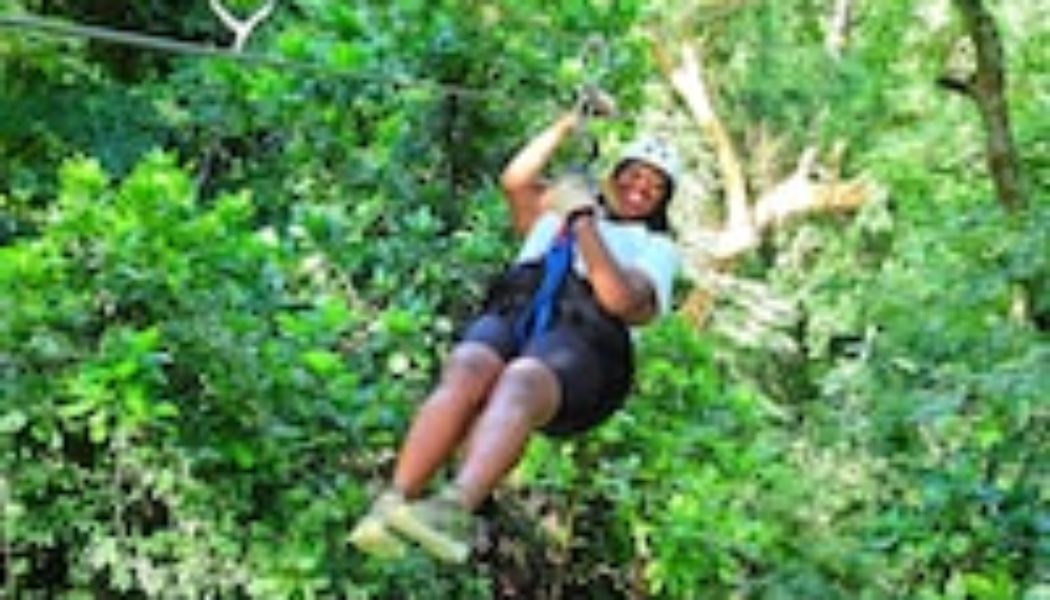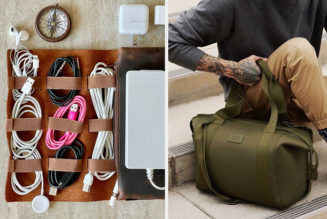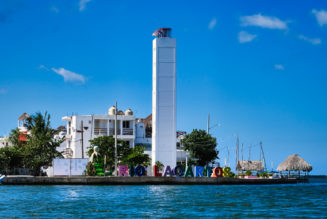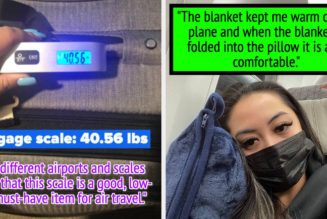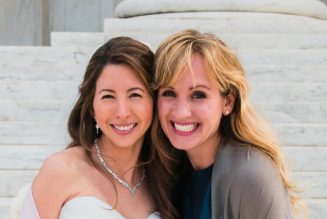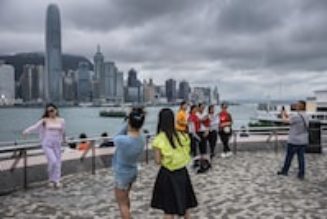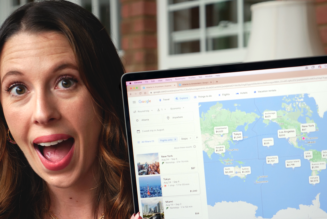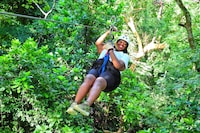
In his new National Geographic show, “Never Say Never” host Jeff Jenkins handles extreme activities with aplomb. He white-water rafts down a waterfall in New Zealand, sumo wrestles in Japan and scales a steep rock face in New York’s Adirondacks. However, one seemingly gentle excursion — walking on a net high above a jungle in Mexico — reduces him to quivers.
At Tulum’s Sfer Ik, the self-described “chubby guy” nervously eyes the webbing that will purportedly hold his plus-size body. He eventually musters up enough courage to sit on the netting, stand up and take a few cautious but victorious steps.
“My mission is not to promote obesity,” Jenkins, 37, said from his home in Austin. “My mission is to help people live life now, no matter their size.”
The Chubby Diaries creator is part of a community of larger-body travelers who are showing the world — and themselves — that they can do anything. They are overcoming physical and mental hurdles in the name of exploration, adventure and inclusivity.
“I think people who are plus-size are blazing the path,” said Alex Stewart, 38, the Chicago-based co-host of the “Swipe Fat” podcast who has snowmobiled on a glacier in Iceland, bungee-jumped in New Zealand and gone skydiving in Chicago. “Following them helps because you can be like, ‘Oh, this place works with larger bodies.’ It’s easier to find those places now, because we have those tools and resources we didn’t have before.”
The experts admit that it’s not always easy, because the travel industry has been slow to adapt to their needs. But their extra efforts are paying off as they discover how to travel comfortably and confidently.
Second plane seats and belt extenders
Jae’lynn Chaney, a plus-size travel blogger and TikTok personality, remembers the second flight she ever took, when she was a 12-year-old unaccompanied minor. Once seated, she reached for the seat belt, but it didn’t fit. She tucked the loose end under her stomach and spent the entire flight petrified of being discovered.
“That was the first time I realized planes were not built for me and I didn’t know what a seat belt extender was,” she said. “My experience was really stressful. I thought they were going to kick me off the plane. I’d be lying if I said that feeling ever went away.”
Now 27 and an experienced traveler, Chaney prepares for every flight by researching the type of aircraft. She prefers wide-body planes, which often have a wheelchair-accessible bathroom. She searches for roomier seats with movable armrests on SeatGuru.
“There’s a lot that goes into traveling as a plus-size person,” said Chaney, who lives in Vancouver, Wash. “I’ve made it my mission to try to change the travel space for plus-size.”
Earlier this year, she drafted a petition that she plans to submit to the Federal Aviation Administration once she reaches her goal of 35,000 signatures (she’s very close, with more than 34,916). In her “Demand for the FAA to Protect Plus-Size Travelers” campaign, she suggests several ways the agency can improve the flying experience for larger passengers. She proposes “a comprehensive customer-of-size policy that prioritizes the comfort and well-being of ALL passengers” that includes a free second airplane seat or reimbursement for passengers who had to purchase additional space.
“Many plus-size people are burdened financially because they have to buy a second seat, or they’re scared that they need to buy a second seat,” she said. “That’s preventing a lot of people from now traveling.”
When asked about the issues facing plus-sized passengers, the FAA shared a link to a 90-day public comment period from last year that addresses minimum seat dimensions and passenger safety. The agency said it is reviewing thousands of comments concerning this topic.
The Transportation Department recently announced a rule that improves restroom accessibility on single-aisle aircraft. According to the law, there must be enough room for a passenger with a disability and an attendant to “approach, enter, and maneuver within as necessary to use the aircraft lavatory.”
Southwest is one of the few airlines to offer plus-size passengers a complimentary second seat, a policy it implemented decades ago. To ensure the extra space, Southwest recommends booking both seats in advance and then requesting a reimbursement. On departure day, travelers can also speak with a gate agent about securing a Seat Reserved Document, assuming space is available.
Similarly, passengers on flights operated by Alaska Airlines and its subsidiary, Horizon Air, can seek reimbursement for a second seat as long as the plane was not sold out.
In Canada, airlines must adhere to “One Passenger, One Fare” on domestic routes. The law defines obesity as a disability, and carriers such as Air Canada and WestJet must cover the second seat for passengers who medically qualify.
“It’s fantastic to have more airlines make it more possible to buy a second seat or get a second seat for free,” said Tigress Osborn, chair of the National Association to Advance Fat Acceptance. “But you still have to grapple with how all the other customers are looking at you as you come down that airplane — the emotional stuff.”
Many airlines use the armrests to determine whether a passenger requires more space. Southwest, for instance, states, “The armrest is the definitive gauge for a Customer of size. It serves as the boundary between seats. If you’re unable to lower both armrests and/or encroach upon any portion of a seat next to you, you need a second seat.”
Even if your frame fits between the lowered arms, you may still need a seat belt extender. Airlines provide this accessory free, and you can request it at the time of boarding.
“Ask right when you get on, so you don’t have to sit and try it and then flag somebody down,” said “Swipe Fat” co-host Nicci Nunez, who lives in Chicago. “They’ll hand it right to you, or if they don’t have it, they’ll bring it to your row.”
Nunez, 33, said travelers should not be embarrassed about needing an extender, noting that a range of passengers use it, such as pregnant people.
Finding size-inclusive excursions
For Natalie Robinson, zip-lining in Costa Rica dominated her bucket list.
“Literally for the last 10 years, that’s all I talked about,” said the co-owner of Fat Girls Travel Too, a travel group. “But zip-lining generally has a weight limit, so I hadn’t been able to do it.”
Her fortunes reversed on an August trip to Costa Rica, when a friend found an outfitter without weight restrictions. The guide said Robinson could swoop through the rainforest as long as she could reach the starting point high in the tree tops.
“Sure enough, I got up there and did 10 lines of zip-lining,” said the 35-year-old attorney from Fairfax, Va. “It was just an amazing, amazing experience.”
Annette Richmond, the 38-year-old creator of Fat Girls Traveling and editor in chief of the Fat Girls Guide, said many attractions and activities are not one-size-fits-all, such as kayaking, helicopter tours, horseback riding and swinging.
After trekking to the top of a rice terrace in Ubud, she settled into a swing, only to discover that the harness was too small. Full of disappointment, she told the swing operator that he would attract more customers if he invested in a range of harness sizes.
“There’s nothing worse than showing up for an experience only to be turned away because of your size,” said Richmond, who located an accessible outfitter on a subsequent trip to Bali.
Pack your own gear
When researching an excursion, ask about weight restrictions as well as the availability of equipment that can accommodate your size. If you have concerns, bring your own gear.
To cage-dive with great white sharks in South Africa in 2018, Jenkins worried that the outfitter might not carry a wet suit in his size. So he bought one online and flew it halfway around the world.
“If it’s something I really want to do,” said Jenkins, whose wet suit appears in the Mexico episode, “I’m going to take matters into my own hands.”
Plus-size travelers stress the importance of being self-sufficient. Finding special garments and accessories can be challenging in unfamiliar destinations.
Chaney carries a seat belt extender for car rides in new destinations. On a trip to the Big Island in Hawaii, she realized that she had forgotten her belt at home. She used the plane’s WiFi to search for the item and found a shop with one belt left in stock.
“If had they not had it, I would not have been able to use the vehicle we rented, because I couldn’t buckle the seat belt,” she said. “I would be putting my safety at risk.”
Richmond, who lives in Playa del Carmen, Mexico, always prepares for a wardrobe disaster. She packs every garment of clothing she’ll need for a trip and throws a couple of outfits into her carry-on in case the airline loses her luggage.
Her strategy paid off on a trip to London last month, when her luggage arrived several days late. Local stores did not carry her size-20 attire. Fortunately, she only needed to pick up a few common goods.
“My biggest fear was that I’d be going from shop to shop in London looking for underwear in my size,” she said, “but the only items I needed to purchase were some toiletries.”
Find supportive travel groups and trips
Plus-size travelers share their challenges and successes with the greater community. In some respects, they are pioneers opening up new lands for others.
Jenkins, Chaney and Richmond post travel tips on their multiple social media platforms. On his YouTube channel, “Fat Tested Travel,” Jason Vaughn samples rides at amusement parks around the country. A private Facebook group called Disney Plus Size Riders And More boasts 14,000 members. (Some theme parks will set up a test seat outside the ride, so you can know whether you fit before you stand in line.) Kirsty Leanne Travels, who is based in the United Kingdom, covers the whole spectrum of travel, from anxiety to getting a tattoo abroad.
Travel companies that cater to larger body groups offer an even higher level of comfort and ease. The “Swipe Fat” hosts and TrovaTrip organize two international trips a year; next month, they head to Spain. This year, Fat Girls Traveling has led fat-positive trips in Upstate New York, England and Cuba. Fat Girls Travel Too has a jam-packed calendar with trips to Morocco, New Orleans, Egypt, Colombia and Cuba.
“We want to give you the same experience without having to worry about any limitations,” said Ashley Wall-Webb, the 31-year-old founder and co-owner of Fat Girls Travel Too, who lives in Emporia, Va.
For a Cuba trip in 2019, she planned an alternative to horseback riding in Vinales, a popular excursion in the valley. Instead of equines, the group cruised around the tobacco farmland in a fleet of classic cars.
